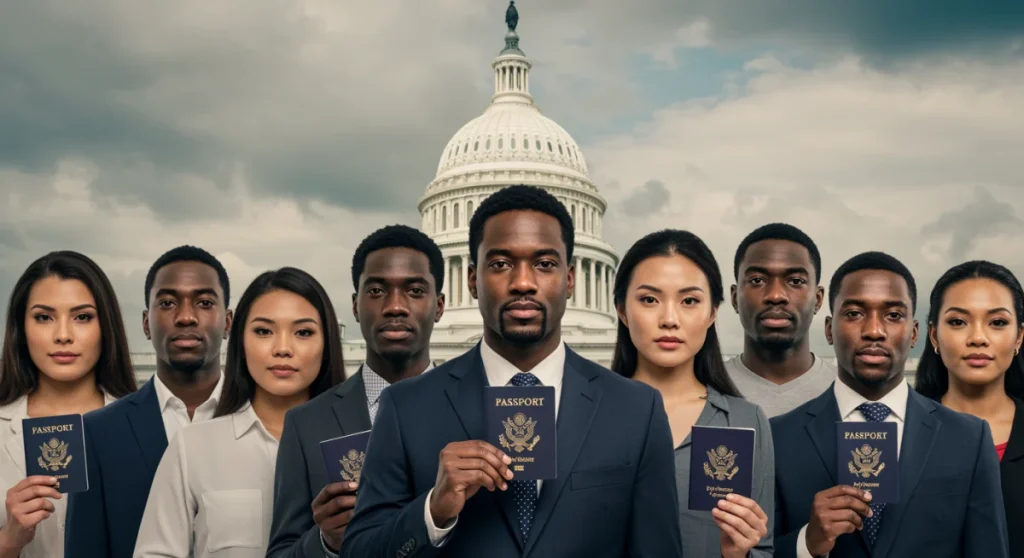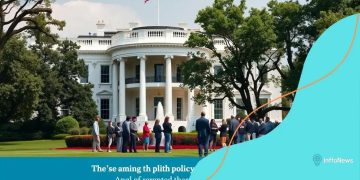Immigration Reform: Bipartisan Bill to Halve Visa Processing Times

Anúncios
A new bipartisan bill has been introduced, seeking to fundamentally streamline U.S. visa processing and reduce wait times by six months, addressing critical bottlenecks in the current immigration system.
Anúncios
The introduction of a new bill aimed at significantly reducing U.S. visa processing times marks a pivotal moment in the ongoing discussion surrounding bipartisan visa reform. This legislative effort seeks to cut current wait times by six months, addressing a long-standing issue that has impacted countless individuals, families, and businesses across the nation.
Understanding the Visa Processing Challenge
For years, the United States immigration system has faced criticism for its convoluted and often excessively long visa processing times. These delays are not merely administrative hurdles; they represent significant obstacles for individuals seeking to reunite with family, professionals aiming to contribute to the U.S. economy, and students pursuing educational opportunities. The current system, burdened by backlogs and outdated procedures, has created a bottleneck that affects various aspects of American life and global relations.
Anúncios
The complexity of the visa application process, coupled with insufficient resources and fluctuating demand, has led to a situation where applicants often wait months, and in some cases, years, for their applications to be reviewed. This uncertainty can be devastating, impacting personal plans, employment opportunities, and even critical medical treatments. Businesses, too, feel the brunt of these delays, as they struggle to bring in essential talent or expand their operations due to the inability to secure timely visas for foreign workers.
The Human Cost of Delays
- Family Separation: Lengthy wait times often mean families remain separated for extended periods, causing emotional distress and financial strain.
- Economic Impact: Businesses face talent shortages, project delays, and reduced competitiveness when skilled workers cannot obtain visas promptly.
- Educational Barriers: International students might defer or abandon plans to study in the U.S. due to uncertain visa outcomes, leading to a loss of diverse perspectives and tuition revenue for American institutions.
Recognizing these profound challenges, the bipartisan initiative aims to inject much-needed efficiency into the system. The proposed changes are designed to not only alleviate the current backlogs but also to establish a more responsive and predictable visa processing framework for the future. The ultimate goal is to create a system that is fair, efficient, and reflective of America’s welcoming spirit, while also safeguarding national security interests.
The Bipartisan Bill: Key Provisions and Goals
The recently introduced bipartisan bill represents a significant step towards modernizing the U.S. visa processing system. Crafted through collaboration between members of both major political parties, this legislation seeks to implement targeted reforms that can yield tangible results, specifically aiming for a six-month reduction in overall visa processing times. This ambitious goal is underpinned by several key provisions designed to address the root causes of current delays.
One of the primary focuses of the bill is on increasing the efficiency of government agencies responsible for visa adjudication. This includes proposals for enhanced technological infrastructure, additional staffing for consular offices and U.S. Citizenship and Immigration Services (USCIS), and the streamlining of redundant procedural steps. The intent is to create a more agile system that can handle the volume of applications without compromising thoroughness or security.
Core Tenets of the Proposed Legislation
- Technological Upgrades: Investing in advanced digital platforms to automate parts of the application process and improve data sharing between agencies.
- Increased Staffing: Allocating more resources to hire and train visa officers, particularly in high-demand locations, to process applications more quickly.
- Process Optimization: Reviewing and revising existing protocols to eliminate unnecessary steps and standardize procedures across different visa categories.
Furthermore, the bill emphasizes transparency and accountability. It proposes mechanisms for regular reporting on processing times and backlogs, allowing for better oversight and continuous improvement. By setting clear benchmarks and requiring public disclosure of progress, the legislation aims to ensure that the promised reductions in processing times are not only achieved but also sustained. This commitment to efficiency and transparency is crucial for rebuilding trust in the immigration system and providing clarity for applicants.
Impact on Various Visa Categories
The proposed immigration reform, with its focus on reducing visa processing times, is expected to have a broad and positive impact across various visa categories. From family-based petitions to employment-sponsored visas and student permits, the streamlining efforts are designed to alleviate pressures felt by diverse groups of applicants. The current delays disproportionately affect certain categories, and this bill aims to bring relief where it is most needed.
For family-based visas, where wait times can often stretch into years, a six-month reduction would mean quicker reunions for spouses, children, and other relatives. This is not just an administrative improvement but a deeply human one, addressing the emotional toll of prolonged separation. Similarly, for employment-based visas, faster processing would enable U.S. businesses to more readily access the global talent pool, filling critical skill gaps and fostering innovation. This responsiveness is vital for maintaining America’s competitive edge in the global economy.

Student visas, too, stand to benefit significantly. International students are a valuable asset to American universities, bringing diverse perspectives and contributing billions to the economy. Reduced processing times would allow prospective students to plan their education with greater certainty, reducing the risk of missing enrollment deadlines or forgoing opportunities due to administrative delays. The ability to secure a student visa in a more predictable timeframe would make the U.S. a more attractive destination for global academic talent, strengthening educational institutions nationwide.
Beneficiaries of Expedited Processing
- Family Reunification: Spouses, children, and parents awaiting family-sponsored visas.
- Skilled Workers: Professionals and specialists seeking employment-based visas (e.g., H-1B, L-1) to contribute to U.S. industries.
- International Students: Individuals pursuing academic programs in the U.S. (F-1 visas).
- Tourism and Business Travel: Visitors seeking B-1/B-2 visas for short-term stays, benefiting from more predictable scheduling.
Beyond these specific categories, the ripple effect of improved efficiency could extend to humanitarian cases and other specialized visas, ensuring that all applicants experience a more equitable and timely process. The comprehensive nature of the bill’s approach aims to create a more functional and humane immigration system for everyone involved, reinforcing the nation’s values and pragmatic needs.
Economic Benefits of Streamlined Visa Processing
The economic implications of streamlining U.S. visa processing are substantial and far-reaching. Reducing wait times by six months is not merely an administrative convenience; it is an economic stimulus that can unlock significant growth, foster innovation, and enhance America’s global competitiveness. When skilled workers, entrepreneurs, and international students can enter the country more efficiently, the entire economy benefits.
Faster processing for employment-based visas means that U.S. companies can fill critical positions more quickly, preventing project delays and maintaining productivity. This is particularly crucial in sectors facing labor shortages, such as technology, healthcare, and engineering. By attracting and retaining top global talent, American businesses can innovate faster, expand operations, and create more jobs for domestic workers. The ability to swiftly onboard international experts ensures that the U.S. remains at the forefront of global technological and scientific advancements.
Key Economic Advantages
- Increased GDP: More efficient entry of skilled workers and entrepreneurs directly contributes to economic output.
- Innovation Boost: Access to diverse global talent fuels research, development, and new business creation.
- Job Creation: Businesses that can grow due to timely talent acquisition often create more jobs for U.S. citizens and residents.
- Enhanced Competitiveness: A responsive immigration system makes the U.S. a more attractive destination for global talent and investment, strengthening its position on the world stage.
- Tourism and Education Revenue: Quicker processing for visitor and student visas boosts industries reliant on international engagement.
Moreover, the influx of international students and tourists, facilitated by quicker visa approvals, directly contributes to local economies through spending on tuition, housing, goods, and services. This creates jobs in education, hospitality, retail, and transportation sectors. The bipartisan bill’s focus on efficiency, therefore, is not just about immigration policy; it is a strategic economic move that could yield widespread prosperity and reinforce the United States’ position as a global leader.
Challenges and Opposition to Visa Reform
While the bipartisan bill to streamline visa processing carries significant promise, it is not without its challenges and potential opposition. Immigration reform, by its very nature, is a deeply complex and often contentious issue in American politics. Even seemingly straightforward efforts to improve efficiency can encounter hurdles related to security concerns, resource allocation, and differing ideological perspectives on immigration policy.
One of the primary concerns often raised about expediting visa processes is the potential impact on national security. Critics may argue that faster processing could compromise the thoroughness of background checks and vetting procedures, potentially allowing individuals who pose a risk to enter the country. Addressing these concerns will be crucial for the bill’s success, requiring assurances that enhanced efficiency will not come at the expense of robust security protocols. The legislation must demonstrate how it can accelerate processing while simultaneously bolstering, or at least maintaining, current security standards. This could involve leveraging advanced data analytics and inter-agency cooperation rather than simply cutting corners.
Potential Obstacles to Implementation
- Security Concerns: Balancing faster processing with robust national security vetting.
- Resource Constraints: Ensuring adequate funding and staffing for proposed technological upgrades and increased personnel.
- Political Divides: Overcoming partisan disagreements on broader immigration issues that could stall specific reform efforts.
- Technological Integration: The complexity of integrating new systems with existing legacy infrastructure across multiple government agencies.
Furthermore, the implementation of such reforms requires significant financial investment in technology and human capital. Securing the necessary funding and ensuring effective deployment of new systems and personnel can be a logistical challenge. Political opposition might also arise from those who believe that any form of immigration reform should be part of a larger, more comprehensive package, or from those who fundamentally disagree with increasing immigration levels. Navigating these various interests and building consensus will be a delicate balancing act for the bill’s proponents, but the bipartisan nature of its introduction offers a glimmer of hope for overcoming these inherent difficulties.
The Path Forward: Legislative Process and Future Outlook
The introduction of the bipartisan bill to streamline visa processing marks the beginning of a potentially long and intricate legislative journey. Understanding the path forward involves recognizing the various stages a bill must navigate through Congress, the potential for amendments, and the ultimate goal of enactment into law. This process requires not only sustained political will but also public support and advocacy to maintain momentum.
Once introduced, the bill will typically be assigned to relevant committees in both the House of Representatives and the Senate. Here, it will undergo review, debate, and potentially be subject to hearings where experts and stakeholders can offer testimony. This committee stage is critical, as it allows for detailed examination and often leads to revisions that refine the bill’s provisions. Building consensus within these committees will be essential for the bill to advance to a floor vote in either chamber.
Key Steps in the Legislative Journey
- Committee Review: Detailed examination, debate, and potential amendments in relevant House and Senate committees.
- Floor Vote: If passed by committees, the bill proceeds to a vote by the full House and Senate.
- Conference Committee: If versions passed by each chamber differ, a conference committee resolves discrepancies.
- Presidential Assent: The final, agreed-upon bill is sent to the President for signature, veto, or allowing it to become law without signature.
Should the bill successfully pass both the House and the Senate, it would then be sent to the President for signature. While the bipartisan nature of its introduction suggests a stronger chance of success, the legislative landscape is always unpredictable. The future outlook for this visa reform hinges on continued collaboration between lawmakers, effective communication of its benefits to the public, and the ability to address any lingering concerns. If enacted, this legislation could set a powerful precedent for future bipartisan efforts in immigration reform, demonstrating that common ground can be found to improve a critical system for the benefit of all.
Potential Long-Term Implications of Visa Streamlining
The proposed bipartisan visa reform bill, if enacted, could have profound long-term implications extending far beyond immediate reductions in processing times. A more efficient and predictable visa system could fundamentally alter how the United States is perceived on the global stage, enhancing its attractiveness as a destination for talent, investment, and cultural exchange. These systemic changes could foster a more dynamic and inclusive society, benefiting generations to come.
One significant long-term implication is the potential for improved international relations. Countries whose citizens frequently apply for U.S. visas would likely view a streamlined process as a positive gesture, fostering goodwill and strengthening diplomatic ties. This could lead to increased collaboration on various global issues, from trade to environmental protection. Furthermore, a reputation for efficient immigration services could give the U.S. a competitive edge in attracting the brightest minds and most innovative entrepreneurs from around the world, ensuring a continuous influx of fresh ideas and perspectives.
Enduring Benefits for the Nation
- Enhanced Global Reputation: Positioning the U.S. as a welcoming and efficient destination for global talent and visitors.
- Sustained Economic Growth: A continuous pipeline of skilled workers and entrepreneurs driving innovation and market expansion.
- Cultural Enrichment: Greater diversity in student and visitor populations fostering mutual understanding and cultural exchange.
- Demographic Resiliency: Attracting young, skilled immigrants to counter potential demographic challenges and maintain a vibrant workforce.
Moreover, the modernization of government agencies mandated by the bill could create a more resilient and adaptable immigration infrastructure. This could lay the groundwork for future reforms, making the system more responsive to evolving global needs and challenges. By addressing current inefficiencies, the legislation not only solves immediate problems but also invests in the long-term health and vitality of the nation’s immigration framework, ensuring it remains fair, secure, and beneficial for all stakeholders. The ripple effects of such a reform could shape America’s global standing for decades.
| Key Aspect | Description |
|---|---|
| Core Goal | Reduce U.S. visa processing times by six months across various categories. |
| Key Provisions | Technological upgrades, increased staffing, and process optimization for efficiency. |
| Economic Impact | Boosts GDP, fosters innovation, creates jobs, and enhances U.S. competitiveness. |
| Challenges | Addressing security concerns, securing funding, and navigating political divides. |
Frequently Asked Questions About Visa Processing Reform
The main objective of the bipartisan bill is to significantly streamline the U.S. visa processing system. It aims to reduce current visa wait times by a substantial six months, improving efficiency and predictability for applicants across various categories, including family, employment, and student visas.
While the bill intends to impact all visa categories, family-based reunification visas, employment-sponsored visas for skilled workers, and student visas are expected to see the most significant positive effects. Faster processing in these areas will alleviate long-standing backlogs and provide much-needed relief to applicants and businesses.
The bill proposes several key measures, including investing in advanced technological infrastructure to automate parts of the process, increasing staffing levels at consular offices and USCIS, and optimizing existing procedural steps. These combined efforts aim to create a more agile and efficient system for visa adjudication.
Streamlined visa processing is expected to boost the U.S. economy by enabling businesses to access global talent more quickly, fostering innovation, and creating more jobs. It also enhances America’s competitiveness, attracts international students, and increases tourism revenue, contributing to overall economic growth.
The bill may encounter challenges related to national security concerns, as some may fear faster processing could compromise vetting. Securing adequate funding for technological upgrades and increased staffing, along with navigating broader political divides on immigration, also represent significant hurdles that must be overcome for its successful enactment.
Conclusion
The introduction of this bipartisan bill to streamline U.S. visa processing represents a critical and timely effort to address a persistent challenge within the nation’s immigration system. By aiming to reduce wait times by a significant six months, the legislation promises not only administrative efficiency but also profound humanitarian and economic benefits. While the path to enactment will undoubtedly involve overcoming various legislative and political hurdles, the collaborative spirit behind its conception offers a hopeful outlook. Should this reform come to fruition, it has the potential to foster quicker family reunifications, bolster the American economy through enhanced access to global talent, and reaffirm the United States’ standing as a welcoming and dynamic nation. It underscores the possibility of finding common ground on complex issues, ultimately working towards a more effective and humane immigration framework for all.





